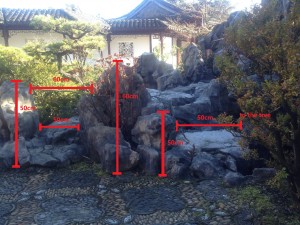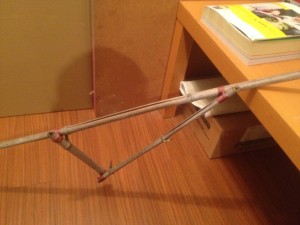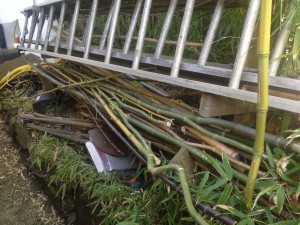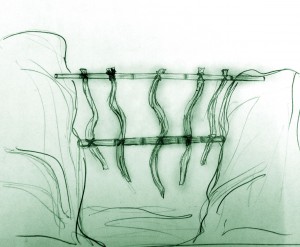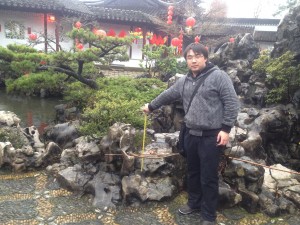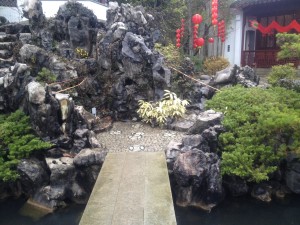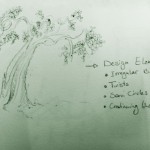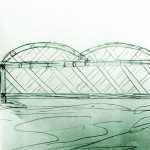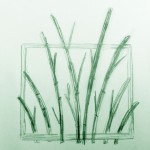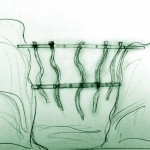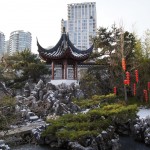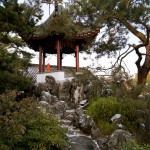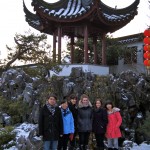As the first blog post, we would like provide some background information regarding our CIVL 202 CSL Project as well as formally introduce our team to you.
What is our project?
The organization that we will be working with is the Dr. Sun Yat Sen Classical Garden, located in Chinatown. We are assigned to build 3 “Ting Barriers”. In Chinese, “ting” means temple, and in the following photos to come, you will see this temple, which is situated on top of a mountain of rocks. The temple is fairly small, and primarily made as a symbolic and decorative piece for the garden. The objective of this project is to build 3 barriers to prevent people from climbing up the mountain of rocks to the temple as there are no hand rails or defined steps to do so. It is very dangerous to climb up the rocks.
A few hours ago, our team met with Claudette, Martin, the Operations Manager at the garden. It was our first meeting with her, and she gave us a brief tour and explained the project to us with details. Key points that we must keep in mind when designing the barriers include the following:
-The barriers must reflect artistic motifs, patterns, or symbols of the Ming Dynasty. For example, materials used to construct the barriers will likely be wood, bamboo sticks and twine; using a drill and building the barriers using nails and metals will not be applicable.
-The barriers must blend in with the surroundings; it should not catch people’s attention but at the same time it should be practical and meets the purpose.
-The barriers must be easily put up and put down to prevent or allow passage.
Claudette also advised us to contact the garden’s architect, Joe Wai, who will give us ideas and feedback over the span of the project. Our team is really excited to design and build these barriers, and we have ideas ourselves already. We cannot wait to share with you when we are able to get the designs on paper in the weeks to come! Here are some photos that our team member Olivia has taken with her new DSLR camera at the site visit today. Enjoy!
Our Team
Our team consists of 6 members – (from left to right according to the photo above) – Andy Yin, Joanne Chow, Azzie Fallahi, Steph Ridenour, Olivia Lund, and Yujin Kim. It is quite ironic how our team was put together; we were all very surprised that our team consists of mostly girls, and only one guy, despite the small girl to guy ratio in our civil engineering department. All in all, we are all very thrilled to work with each other. Our personal bio’s are listed below. We hope to have you come back to our team blog to keep up with our project progress. We will be updating the blog once a week, and we promise eventful posts in the near future!
Andy Yin:
Hi everyone, I’m Andy, and I am from north-east part of China. When I was young, I did well in Math and Physics, that’s why I chose engineering. Civil engineering relies on forces and equilibrium, I love them very much, so I chose Civil engineering to be my career.
Joanne Chow:
Hey everyone, my name is Joanne Chow and I am from Hong Kong. Having a Chinese background, I am very interested in learning more about the history and artistic styles of the Ming Dynasty from this project. Things that I like to do when I have free time include eating and shopping. Even though I am currently majoring in civil engineering, I am hoping to pursue a career that is design-based, perhaps in architecture or industrial design.
Azzie Fallahi:
Hello, I am Azadeh Fallahi and I am part of the team responsible for designing a pedestrian barrier to help with both the safety and the preservation of the Ting and the mountain. Before moving to Canada 2 years ago, I was studying Architecture in Iran and the main reason I am studying Civil Engineering right now is to be able to pursue an architecture career while knowing a thing or two about how the buildings actually hold up. I am very excited and honored to be working on a project that will combine all my passions which are architecture, design, structural engineering and still contain a cultural aspect as well. Looking forward to a constructive collaboration between our team and the management of Dr. Sun Yat Sen Chinese Garden.
Steph Ridenour:
Hello, my name is Steph-
I am from a small town called Duncan, which is located between Victoria and Nanaimo on Vancouver Island. When I was deciding what to go to university for, I was torn between architecture, interior design, and engineering. Luckily I chose the latter! My interests include lightweight rowing, swimming, sailing, travelling and cooking (because who doesn’t love food?). I have a very strong interest in sustainability, and will be embarking on the Environmental Option beginning next year. I look forward to meeting and working with you! Cheers!
Olivia Lund:
Hello, my name is Olivia Lund and I am from Kamloops, BC. I chose Civil Engineering because I have always taken an interest in buildings, bridges, and just structures in general (as a child I constantly played with lego). Some things I enjoy outside of school include dancing (ballet, jazz, contemporary), gardening, travelling, and walking my dogs. I am eager to start working on this project as I am sure it will be both a memorable and meaningful experience!
Yujin Kim:
Hi, I am Yujin Kim and I am from Korea. I came to Canada to study 2 years ago. I chose civil engineering as my major in UBC since I am interested in structures. I am glad to be in civil engineering as I find a lot of interesting knowledge and techniques here. I am sure that our group will enjoy our fantastic project!!
